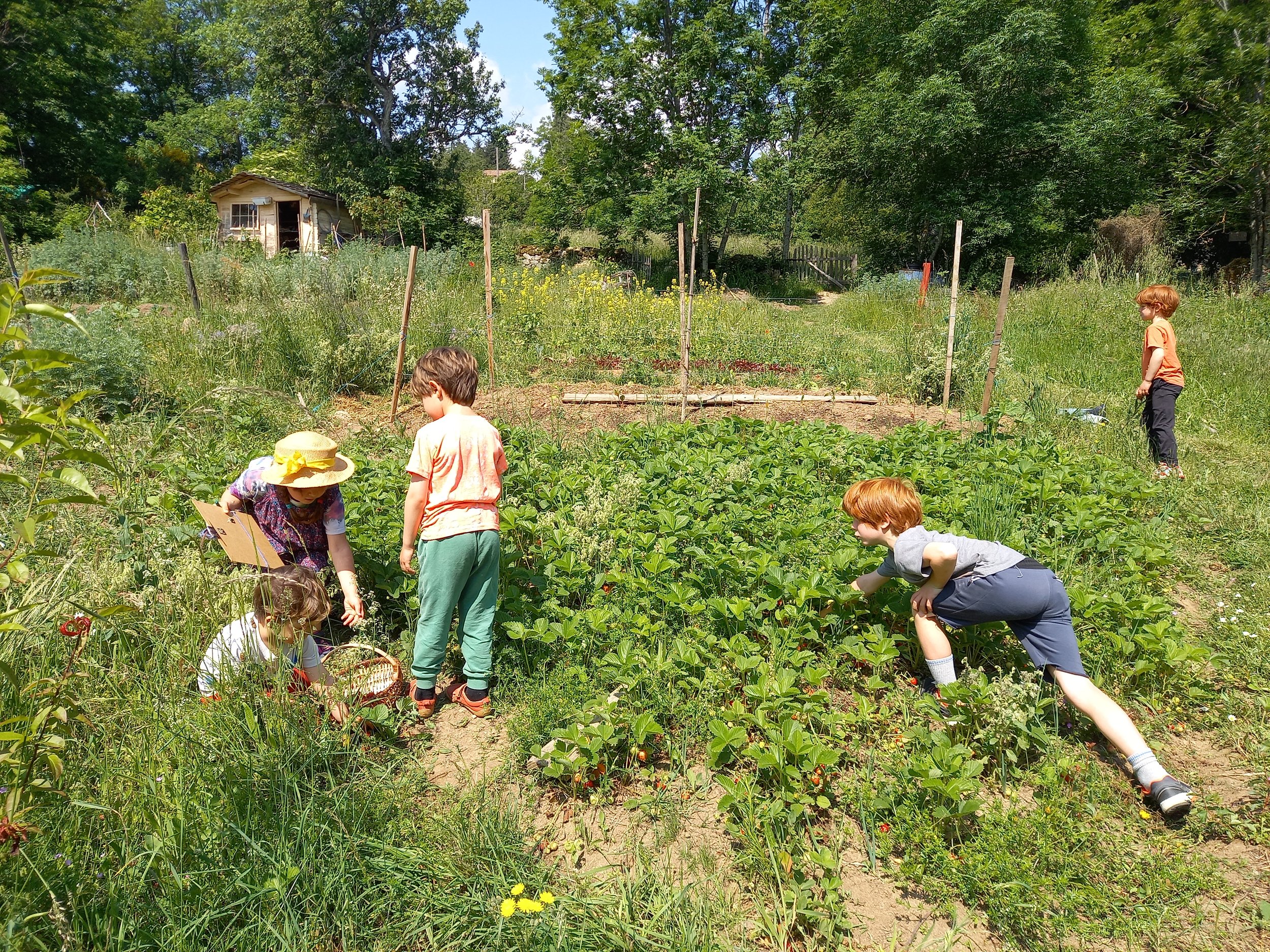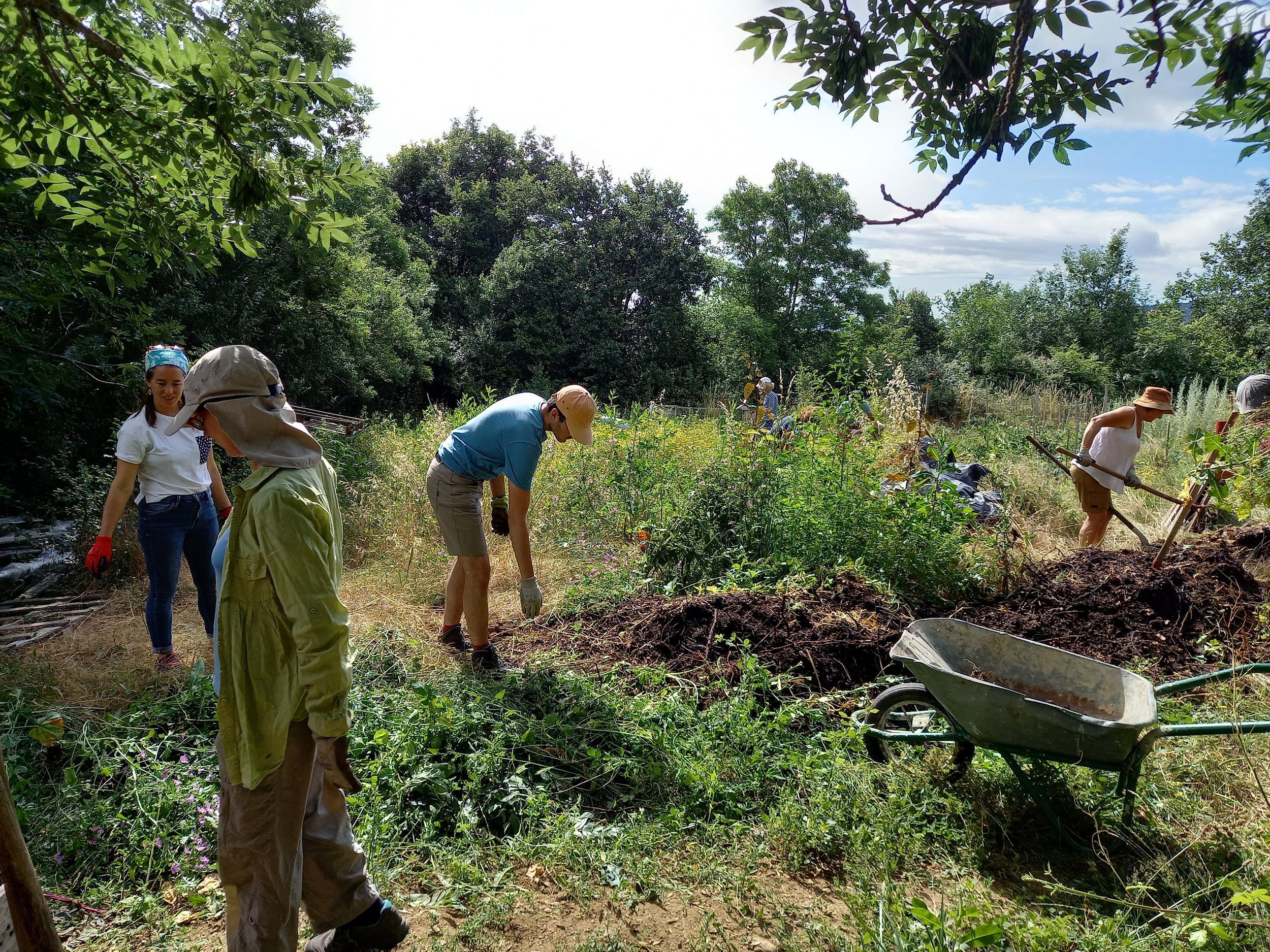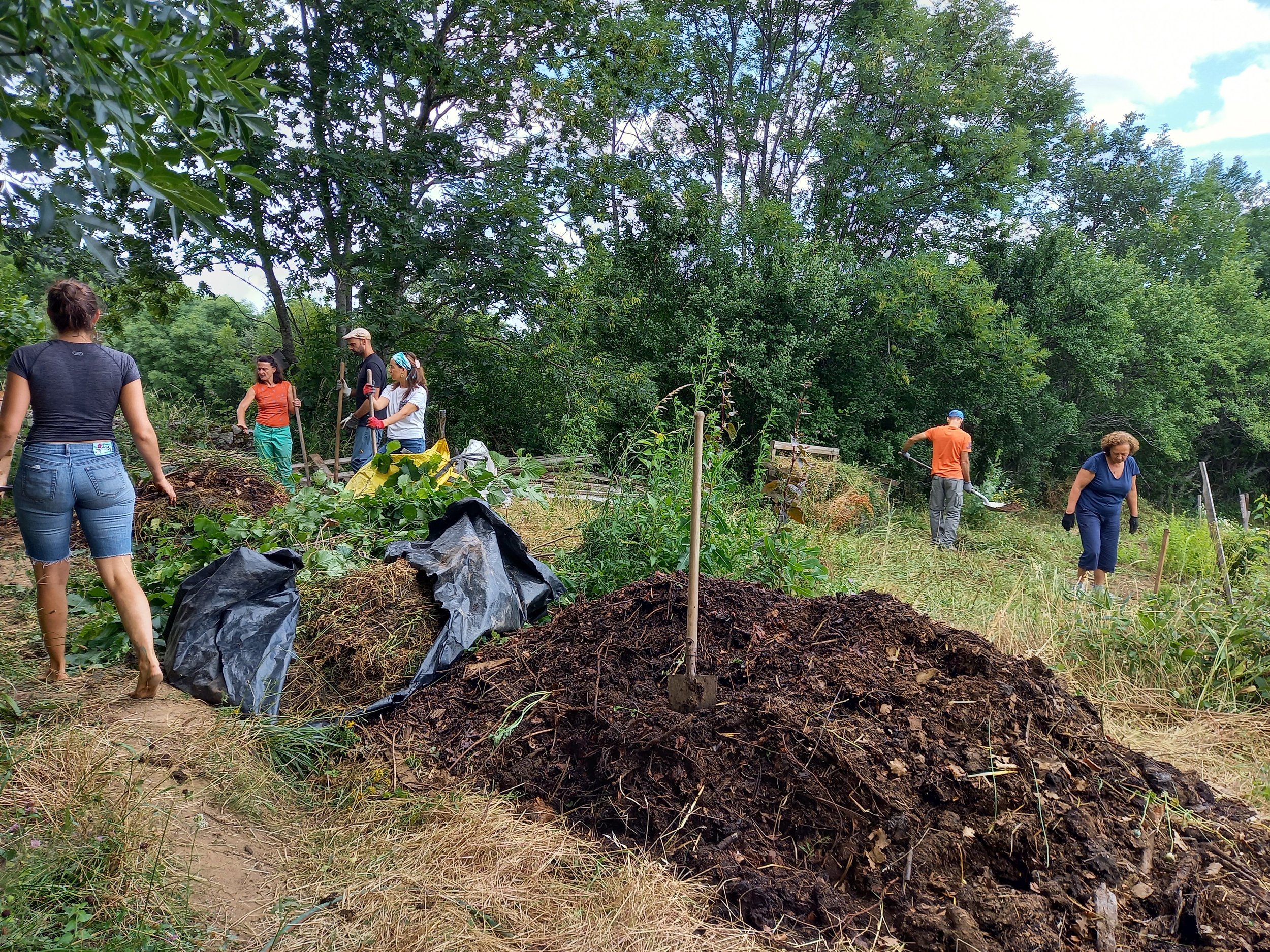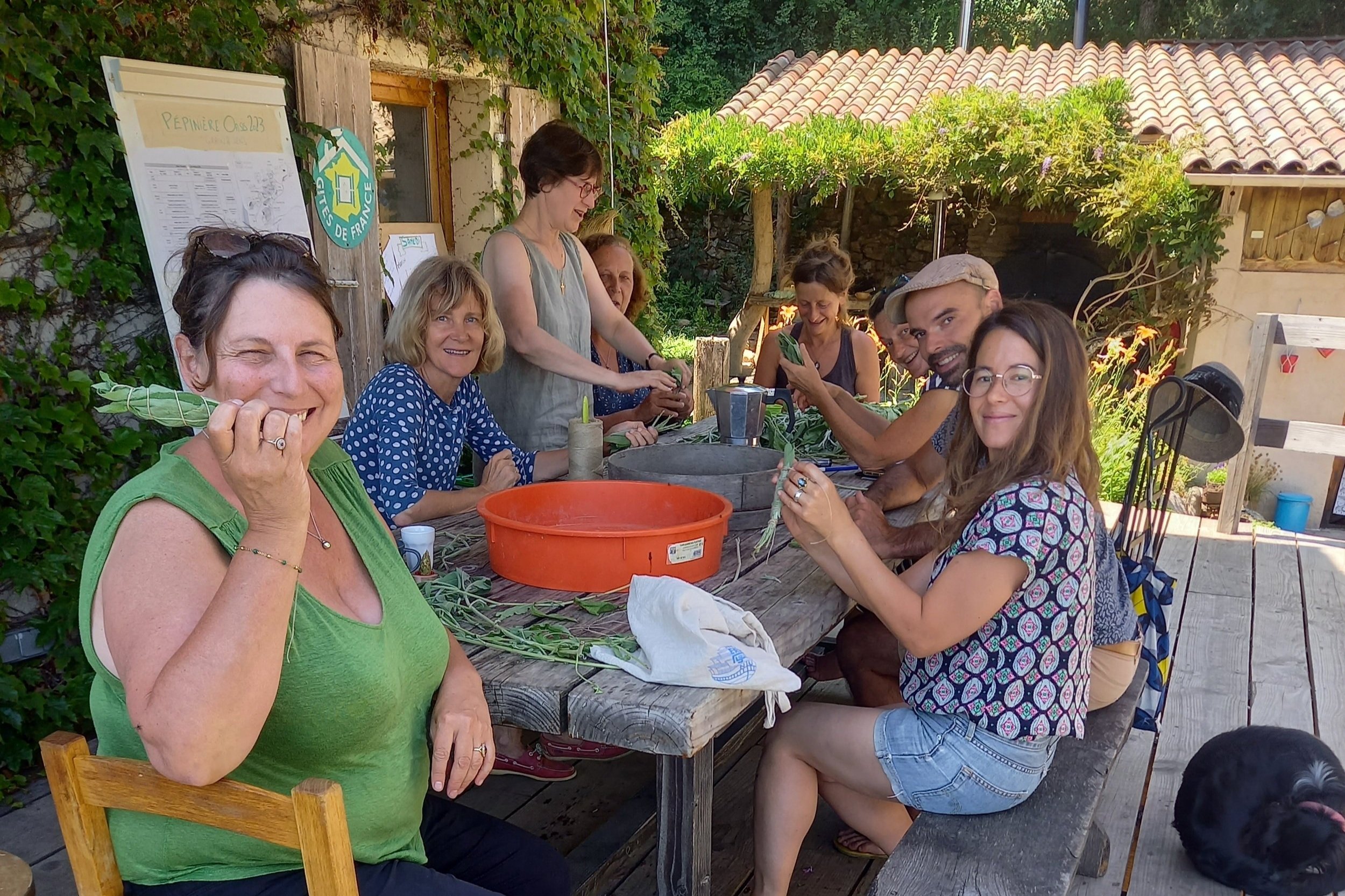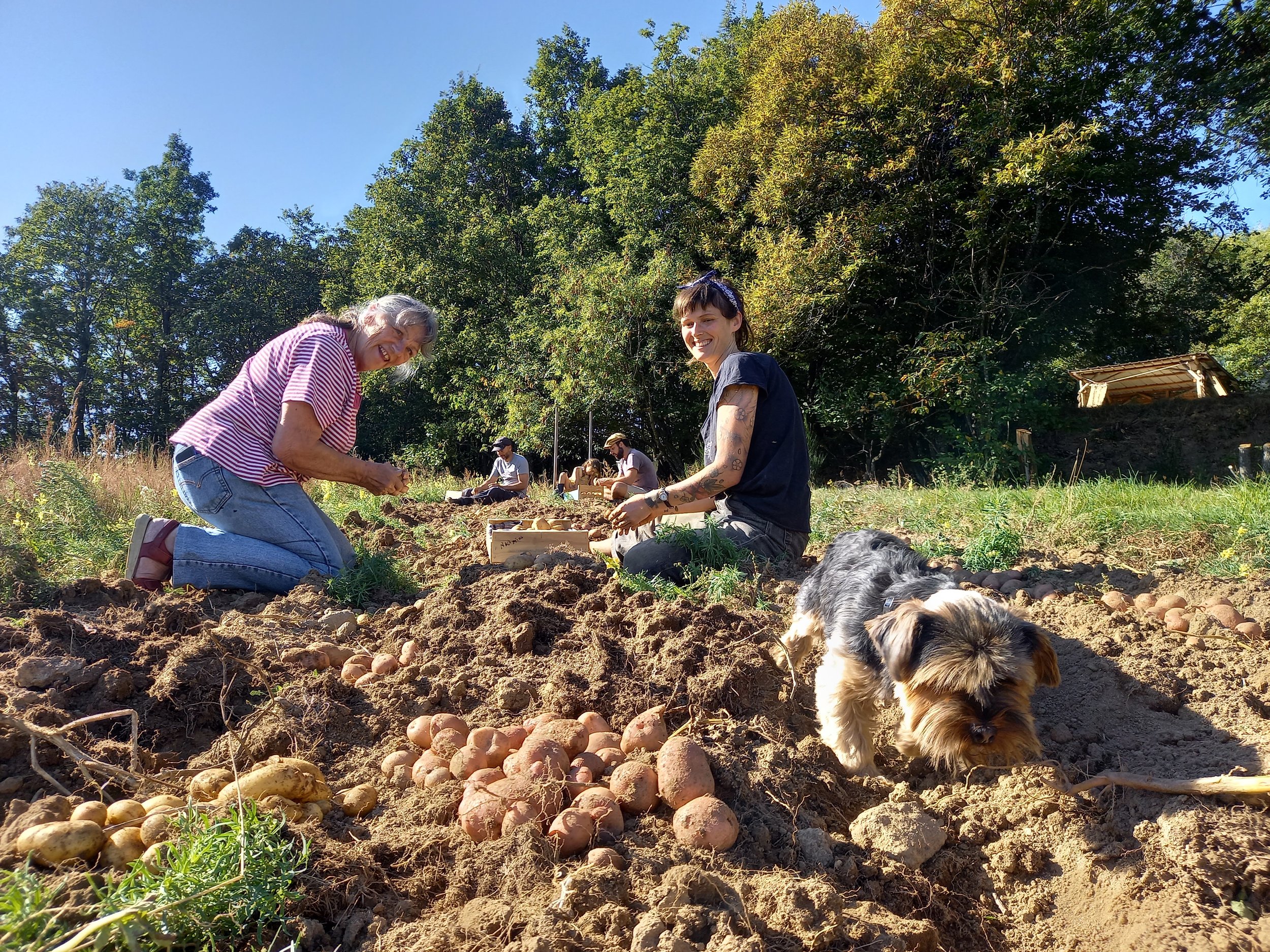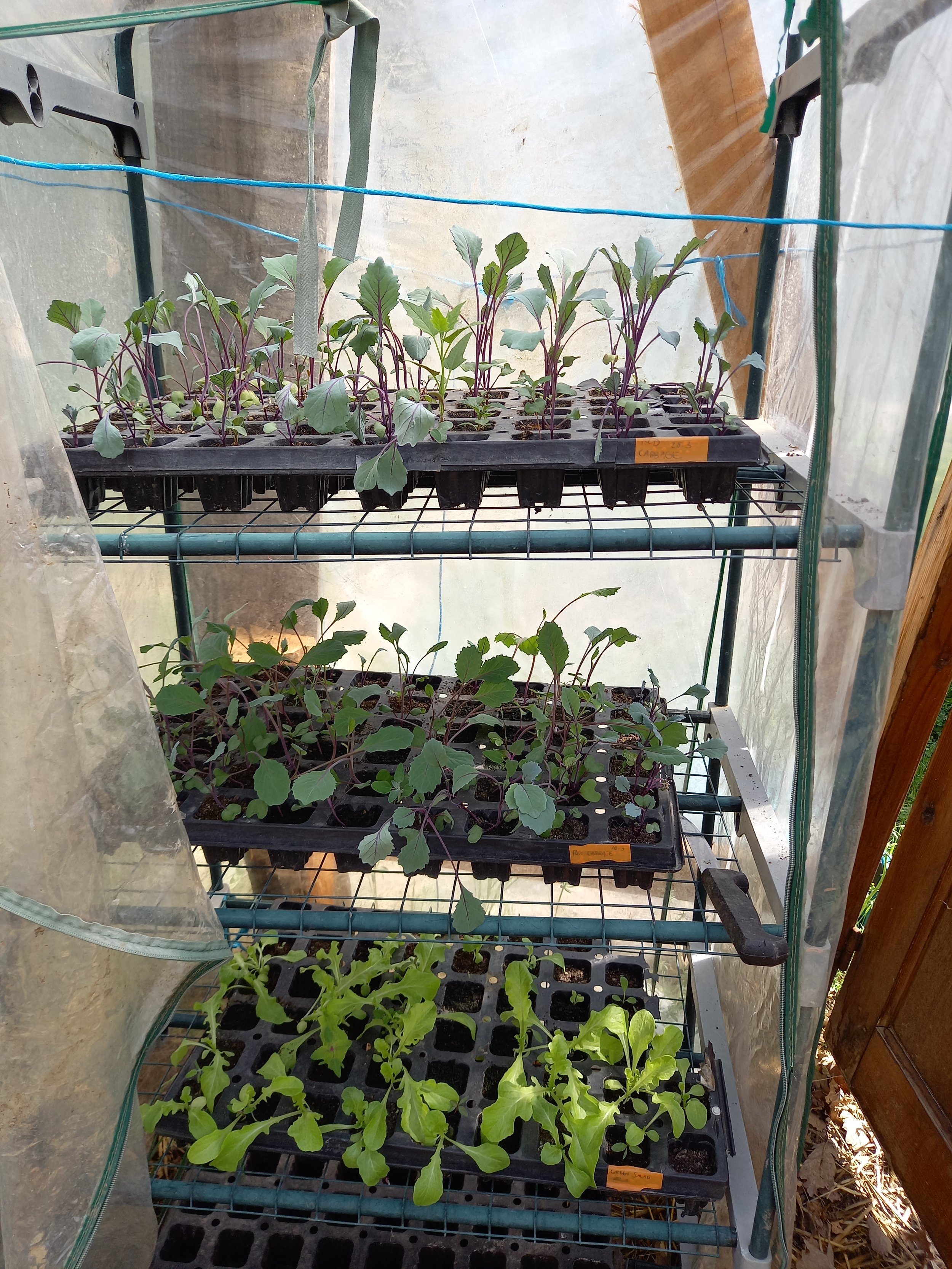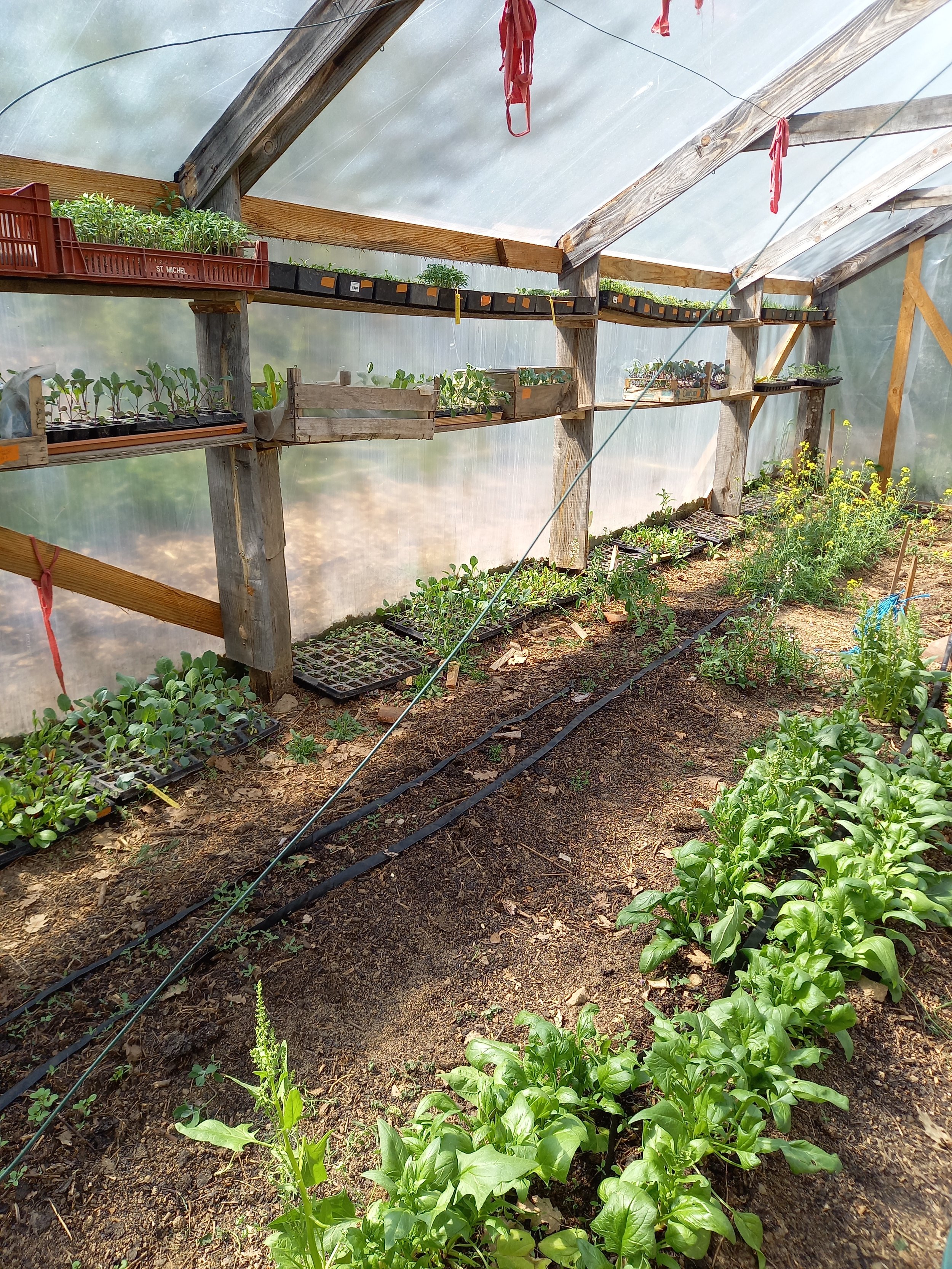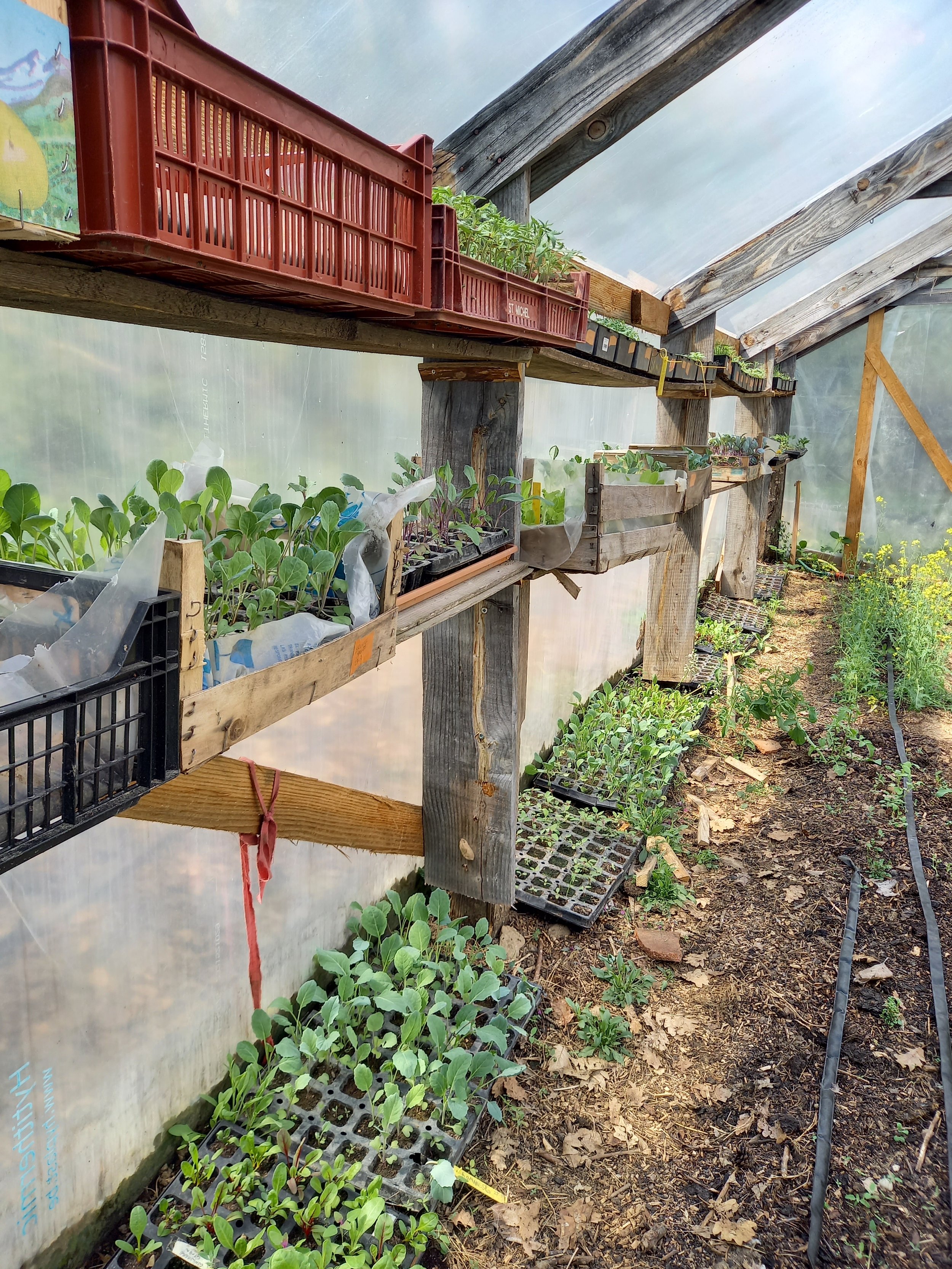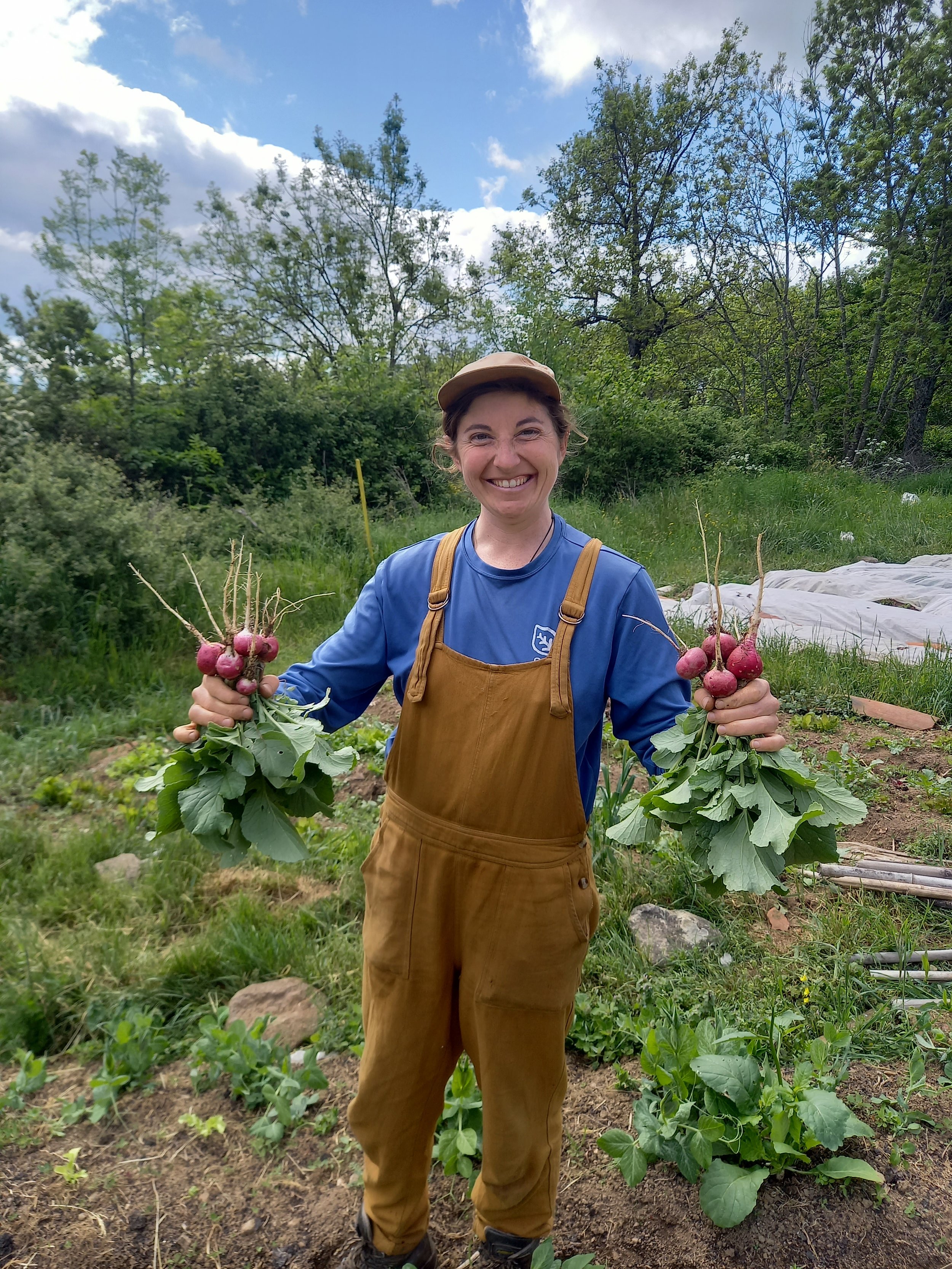The garden season of 2023 was filled with experimentation, successes, challenges, learning lessons, and, of course, lots of vegetables. It was my first season managing the gardens and it was the first season at Grain & Sens in which vegetables from the garden were sold. I experimented with a “self-harvest” system where everyone was welcome to harvest for themselves, weigh their bounty and tally their purchases on a sheet in the garden shed. While this system was mostly utilized by myself and the dream team of garden angels Sarah, Sigrid, Mathilde, and Brad, some collective members and guests staying for camps and trainings did take advantage of the self-harvest system. In total, over 500kg of vegetables were accounted for with a value of 1,500 euros. While it was informative and helpful for me to tally and weigh harvests, the numbers don’t account for how many people, young and old, spent time in the gardens this season to help, harvest vegetables, or simply explore. My goal for the gardens at Lavenant is to find a happy balance between food production and education. I prioritize providing vegetables and food for the collective first and foremost, and secondly for our guests, including eco-campers, people staying for trainings, and families staying for vacation. What follows is a review on the 2023 season, its successes, challenges, and what I look forward to putting in place for the 2024 season.
Mini eco-campers completing a garden scavenger hunt
by the numbers
Over 50 varieties of vegetables were grown over the course of the season, which started in early-March (with greens planted the previous fall). I made detailed plans for how to utilize every bed in the “Spiral garden,” the greenhouse and its surrounding area, and the “La Bas” garden down on the lower terraces (see an overview of the plans in the figure below). The plans were certainly helpful, particularly in the beginning of the season, but by mid-summer I was certainly no longer following the details of the tedious Excel spreadsheet I had made in the winter.
Garden plan summaries
The top 15 veggies in terms of quantity and revenue can be seen in Table 1 below. Leafy greens, which included lettuce, mustard greens, rocket/arugula, mache, baby spinach, and mizuna, remained the season’s best-sellers accounting for approximately 20% of total garden sales. Assorted baskets, which included whatever veggies were available at that time, accounted for a large portion of sales as well. Next where tomatoes, despite it being a very weak tomato season (more to come on this later).
Table 1: Veggies overview
Spring peas came in 4th, with a strong harvest in this year’s cool, wet spring. Peas are fun and easy for people (especially small people) to harvest themselves and were a big hit during our Eco-camps and Mini eco-camps.
Mini eco-campers lost in the peas
Blette (or Swiss chard in English), kale, and beets have been consistent throughout the spring and fall seasons and even now, as I’m writing in January, are still healthfully growing and being harvested for the collective.
who was buying
Table 2 below gives an overview of the top buyers of garden veggies.
Table 2: Top Veggie Buyers
The collective was the #1 “client” of the garden, accounting for around 1/3 of sales and 1/2 of veggies by weight. The collective includes the members of Grain & Sens, but also included anyone staying at Lavenant and participating in our food sharing system, including our summer volunteer team as well as our long-term renters.
Sarah, a member of our summer volunteer team, proud of a particularly large rutabaga
Next was Hetre a Table (HAT), the vegan cooking association that cooks for a large portion of our trainings and camps at Lavenant. HAT accounted for 27% of sales and around 20% of veggies by weight. HAT made a point to prioritize using veggies directly from the garden before buying from other producers, often adapting and gathering inspiration for their menus based on what was available in the garden.
A typical harvest for Hetre a Table.
Ed, Astrid, Will, and Elio were also excellent users of the self-serve system throughout the season (as well as my top egg-customers). The Auberge de Boffres were particularly helpful and supportive in buying greens in the spring and fall when there are fewer guests and demand for veggies at Lavenant. The group Fertile made a point to utilize whatever garden veggies were available when they had trainings at Lavenant. Finally, the jar in the garden shed accumulated a small amount of cash purchases throughout the season.
successes
A mid-season garden party to celebrate harvesting and cooking garden veggies.
Looking back now, there is a lot to feel proud of. For me, the biggest success of the season was welcoming people in the garden and managing the workflow of volunteers. From our two full-time summer volunteers, Sarah and Sigrid, to our one-month-stay woofers, Thomas, Mathilde, and Brad, to the many eco-campers who harvested their meals straight from the garden, plenty of people participated in the gardens at Lavenant this season.
Kids picking strawberries in the garden.
Rather than taking many shorter-stay woofers this year, we opted to take on fewer people for longer stays. Thanks to the enthusiasm and hard-work of our summer team, the workflow often felt both efficient and fun. The garden shed served as the working hub of the garden, with a whiteboard updated weekly with various tasks and jobs to do. The summer team was able to then become autonomous and independent on many tasks over the course of their stays. Not only was this efficient and helpful, but I’d like to believe it created a richer experience for our volunteers, who were able to take ownership over plantings of beds, create crop plans, and give their input and feedback on management decisions.
Volunteers Thomas and Sigrid planting sweet potatoes.
On top of the great workflow from our longterm volunteers, we hosted a number of very fun “chantiers” in the garden. Participants in trainings helped with a number of chantiers including creating and turning compost piles, mulching beds, collecting seeds, making sage and herb bundles, planting cover crops, and canning vegetables. I always find chantiers to be practical in terms of getting things done and a moral boost for myself and the longer-term volunteers.
On the farming side, spring salad greens, peas, and radishes went nicely. Nursing baby plants in the greenhouse also went quite well, with a surplus of transplants in May and beginning of June.
It was a cool and wet spring, so early-season broccoli was surprisingly successful, as well as our early-season root veggies like beets and rutabaga doing particularly well.
Seva showing off a big rutabaga.
I made “3-sisters” mounds, which I found practical, aesthetically interesting, and a good excuse to discuss the importance of the North-American 3-sisters, corn, beans, and squash. Given the hot and dry July we had, corn was by far the happiest sister.
Victoria smiling “ear to ear.”
Late-season red cabbage went well, though it underperformed initial expectations. Jerusalem artichokes have been nice to harvest throughout the winter (we still have plenty in the ground now!), and kale, chard, and rocket have been the winter greens that just keep giving. I’ve been planting a lot of garlic, spinach, salads greens, rocket, cilantro, and parsley in anticipation of a nice green early-spring.
challenges
(Warning: This section is a bit geeky, so if you’re not very interested in the farming details, feel free to skip ahead!)
Irrigation was my #1 pain-in-the-ass this past season. The summer garden team can surely attest to that as they spent hours hauling water down to the greenhouse and hand-watering with watering cans when the well that normally supplies water to the greenhouse dried up in mid-July. I am not very experienced in setting up irrigation systems and I learned a whole lot this year. Our awesome volunteer Thomas, who has an engineering background, helped me out a lot with designing maps of the irrigation plan for the main Spiral garden, but we were limited by the pressure delivered at the main outlet to the garden as well as the type of drip hose lines we were using. I made it through the season spending little investment in the irrigation infrastructure but after such a hot July mid-summer, I vowed to make investments in our irrigation system over the course of this winter and to not have another summer with such an inefficient use of water and time. As the main pipe bringing water from our well to the Spiral garden was destroyed this fall in an unfortunate tractor incident, we will be starting with blank-slate to craft a more professional and efficient watering system this year.
Shelby messing around with irrigation lines.
While the baby plant nursery in the greenhouse overall went well, there were quite a few learnings that came with it as well. I didn’t start my sweet potatoes nearly early enough and we didn’t get them in the ground until July 10th, far too late to end up with a good harvest. I was over-eager with tomatoes, eggplants, and pepper plants and had 4X the baby plants than I actually needed. Next season, my motto is “fewer but stronger” for these nightshades.
I learned a lot about crop-timings specific to our local area from Delphine, a nearby organic farmer I work for part-time. For example, onions can be in the ground as early as end of February, meaning you have to either start them inside with UV lights in beginning of January or buy them from a nursery. I started our onions too late and planted all of them alongside our brassicas. I thought this would be a nice companion planting, but in reality, the too-small onion transplants got quickly lost and over-shadowed under the big brassicas. The long days-to-maturity brassicas like cauliflower, cabbages, romanescos and brussel sprouts, are better started in the greenhouse in June and planted in the ground in July and August for a nice fall harvest. It simply gets too hot in our area by end of June to be able to reliably pull-off an early-season crop. Out of all of my beautiful baby brassica transplants I raised from seed starting in late-March, only broccolis had a nice early-season harvest.
Mulch, mulch, mulch.
Mulch, mulch, mulch. “Mulch as prevention, not symptom-treatment” was an epiphany for me in July, when it was hot and dry and you could watch water evaporate off of any bare ground. I realized quickly that mulching works best before it’s already too dry and you’ve lost the battle of ground moisture.
I love companion cropping (planting multiple crops together in the same bed) and I utilize this technique both to save space and to capitalize on the beneficial relationships plants can have one another. This being said, I found time and time again that it didn’t work well to direct seed in beds where there were still crops planted. For example, in my crop planning, I imagined I would be able to get many plantings of greens out of my beds that had long-term crops like tomato plants, but in practice it was awkward and hard to direct-seed anything that close to another crop. For the future, I’ll try transplanting in beds where I’d like to keep certain longer-term crops.
what lies ahead
I am still in the process of reflecting and planning on the 2024 season. Perhaps a more detailed post with 2024 plans will come in the spring, but for now, projects for this winter include:
Installing roof water catchment systems
Redoing the Spiral garden irrigation system
Redoing the lower garden irrigation system
Increasing water storage for the greenhouse by properly sealing an old nearby concrete basin
Creating a small indoor, heated plant nursery area for early-season seedlings
Starting a small-scale oyster mushroom cultivation in our cave
Beyond the projects above, there will be plenty of small-scale changes in how I garden and farm in 2024. My overall motto will be: less is more; fewer but healthier plants. There is always so much to learn from the garden and I love it for that. I will never master it, I may never even get that good at it, but there is so much abundance in enjoying the ride.
Thanks for reading! Hope to see you in the garden!
-Shelby
Shelby loves radishes










